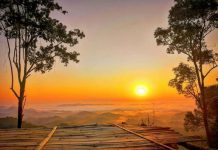
Tracing the Glory of the Past, Sukhothai Historical Park
Sukhothai, the former capital of Thailand which was extremely prosperity as the center of political, religion, and economic. And for one who likes the memorable story and places, definitely, Sukhothai would be top of the mind of the trip in Thailand. Specifically, the world heritage site as ‘Sukhothai Historical Park’ where the place contains lots of ancient remains and archeological finds for you to be thrilled. The wreckages of old palaces, religious sites, and ancient monuments surrounded with the city moat, city wall, and the gate that lined in squared shape with about 2 kilometers long and 1.6 kilometers wide. Each side of the wall is the city gate set in the middle. Inside the historical park still shows the ruins of the palaces and temples also other significant ancient remains for over 30 sites.
The Story of Sukhothai Historical Park
The location of Sukhothai district is on the lower plain of the north region of Thailand. The discovery showed proof of the settlement of the man since the pre-historical period. As stated by the archeological evidence founded in the area of Si Nakhon, Ban Dan Lan Hoi, and Kirimas district showed proof of the pre-historic communities. Later, these communities had existed and gathered to be the state until in 557 this area had contacted to other regions in the central and northeastern which influenced by Dhavaravati culture.
There’s the archeological discovery at Wat Chom Cheun in Si Satchanalai, the pieces of art within the old city region in Sukhothai at Ta Pha Daeng Shrine, and Prang Khao Pu Ja in Kirimas district, for instance. It assumed to be the settlement pattern over the area of Khao Luang plain according to Khmer culture for the first time. And later in the middle of the 18th of the Buddhist Century, the story regarding the independence declaration to rule over the Sukhothai region emerged at that time and then those of the people are the ancestor of the present Thai people.
In 1976, The Department of Fine Arts initiated the master plan to develop the ancient city of Sukhothai to be the historical park. The scenario was proposed in the fourth plan of The National Economic and Social Development Plan (1977 – 1981) and the fifth plan (1982 – 1986) under the project titled “Sukhothai Historical Park Project”. The council of ministers resolved the program and appointed the Department of Fine Arts to implement the property development within the Sukhothai region to be the historical park, at last.
King Rama IX of Siam graciously bestowed the authorization to HRH Princess Maha Chakri Sirindhorn to visit the site on behalf of the king in the official opening ceremony took place on November 20, 1988. Also, it was the nation special occasion for the government, and the people of Thailand celebrated the 5th cycle of King Bhumiphol’s Birthday Anniversary and the Ruby Jubilee.
After then, the 15th World Heritage Committee Session at Carthage, Tunisia officially announced Sukhothai, Si Satchanalai, and Kamphaengphet Historical Park being the cultural world heritage sites dated December 12, 1991. So, they are considered as the 574th list of world heritage.
What Interesting to See at the Historic Site
Sukhothai Historical Park features lots of ancient remains that would be thrilled of both within and outside the city wall. Honestly speaking, it would not be completed you explore for just one trip to experience this location. However, to make your tour at Sukhothai Historical Park more convenient, here are the highlighted spots that you should check in when you visit the park.
1. Wat Mahathat
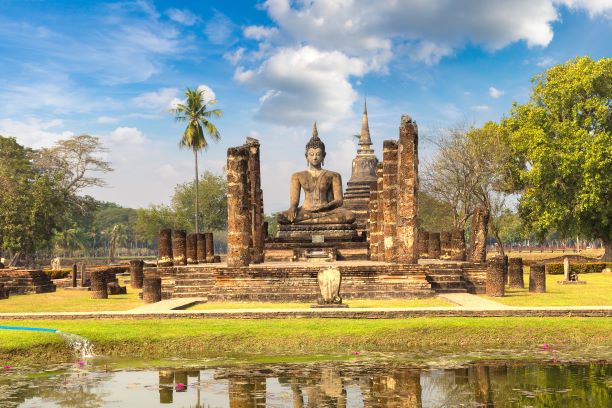
A major and the most significant monastery in the Sukhothai era included more than 200 pagodas in total. The great pagoda which is the main structure of the complex is in the lotus-shaped that is the classic style of art of the Sukhothai. The grand pagoda surrounded with 8 satellite chedis on the same platform including the laterite prang style pagodas located in 4 directions and the pagodas that is the mixed of Srivijaya and Lanka style at the corners. Moreover, there is another spot that is not less in its importance which is “Phra Sri Sagaya Munee Vihara” or “Vihara Luang” (the royal chapel) a house to enshrine the important Buddha image “Phra Sri Sagaya Munee” a magnificent and venerable Buddha statue in Sukhothai art.
2. Ramkhamhaeng National Museum

A location where stored the numbers of collections and ancient art derived from the excavation within the area of Sukhothai city also donated by the people, for example, Buddha images, utilities, pottery, celadon wares, and the ancient inscribe since the Sukhothai era. The museum is allocated the space to display the collection into 3 zones which are;
- Lai Sue Thai 700 years Hall, a new building that set in the front of the main hall where the place exhibits the archeological finds and pieces of art since the Sukhothai Kingdom, such as the Buddha images, pottery, celadon wares, and inscription.
- The Museum Hall which is a 2-level building displays the pieces of art in the various era, for example, the bronze Buddha images, earthen jar, celadon wares, weapon, coin, a drainage ditch in the Sukhothai period, etc.
- Outdoor Museum that is the area outside the main building. The outdoor museum features numerous archeological finds, such as the stone Buddha images, the inscription, models of the various type of Thai architecture, Turieng Kiln, Buddhist Wheel of Life, etc.
Ramkhamhaeng National Museum opens for the public and tourist every day between 9.00am – 4.00pm with THB30 per person for the entrance fee.
3. Ta Pha Daeng Shrine
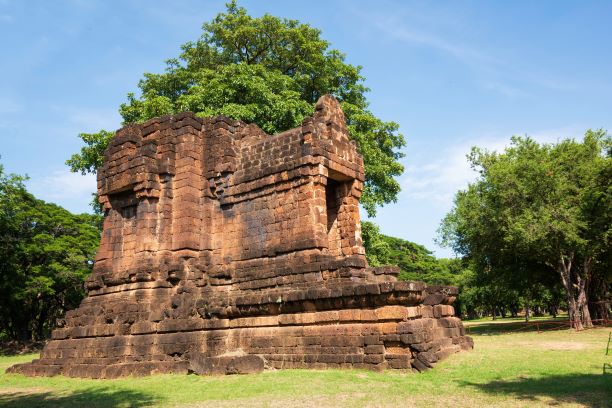
An ancient ruin which was built followed to Khmer style in Angkor Wat period (1107 – 1157). Later, the Department of Fine Arts did the excavation and restoration of the site and founded the graven images of god and goddess with ornaments. Those figures are compared to the same period of Angkor Wat era. Ta Pha Daeng Shrine considered as the oldest historical site in Sukhothai province that presently nestled within the land of Ramkhamhaeng National Museum.
4. Neon Prasart Phra Ruang
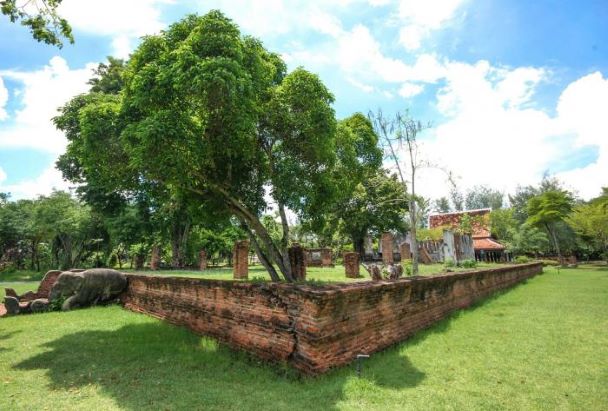
Also known as the royal court area in the Sukhothai era where the place is in the east adjacent to Wat Mahathat. Neon Prasart, King Rama VI of Siam assumed that space was the base of the royal court or the throne hall of the king of Phra Ruang Dynasty who ruled the Sukhothai Kingdom. The hill is the location to discover the notable inscription and the stone throne called ‘Manangkasila’ of King Ramkhamhaeng the Great. The site was excavated and repaired by the Department of Fine Arts in 1983 and saw about the foundation of the structure in the lotus base. The design is in squared shape with the dimension is 27.50 x 51.50 meters; also it has the staircase at the front and the rear of the structure.
5. Wat Traphangngoen
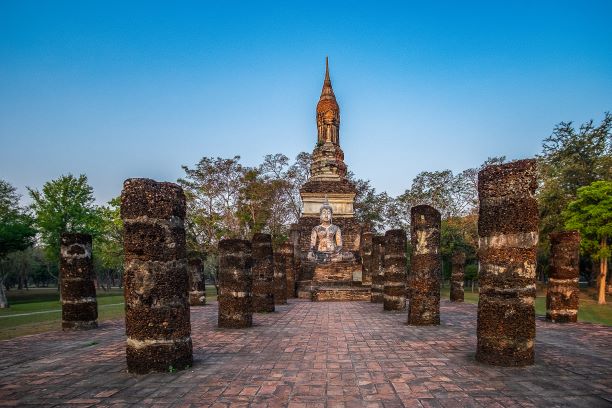
Or Traphangngoen Temple is the ancient ruin situated at the edge of Traphangngeon. The word “Traphang” means pool or swamp. In the west, there’s a lotus-shaped pagoda as the main structure, and the stucco figures of the standing Buddha enshrined in 4 directions. At the front area is 7-partition vihara with the laterite platform and pillar. Inside the hall housed the sculpture of the Buddha image in the attitude of subduing Mara. In the middle of the pool is a small isle which set up the ubosot or the ordination hall surrounded with the outstanding beauty of the lotus flowers in the pond.
6. King Ramkhamhaeng the Great Monument
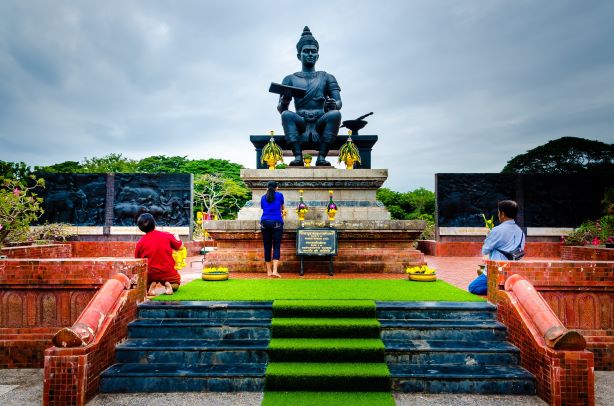
Established in 1975, King Ramkhamhaeng the Great Monument stands at the side of Jarotwiteetong road in the north of Wat Mahathat. The statue of the significant king of the Sukhothai Kingdom made from brass mixed with black copper with double size of the actual scale. The 3-meter high statue sits on the Manangkasila Throne; the book is in the right hand while the left-hand post in the attitude of teaching the people. At the left side of the figure is the tray with a sword. The face performs the unique character of the early Sukhothai’s Buddha image which expresses kindness, justice, and decisiveness in the paternalism. At the side, there’s the inscription recorded the significant incidents regarding his royal duty as referred in the archive of Sukhothai.
7. Wat Sasi
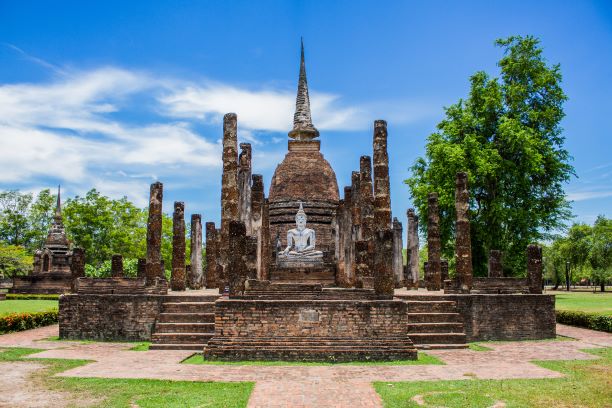
A unique and old temple is in the northwest of Wat Mahathat. The monastery is an important holy place situated in the middle of the large pond called ‘Traphangtraguan’. Within the complex is Ceylonese style pagoda and at the front of the elegant vihara is the stucco image of subduing Mara Buddha. Also, there’s a small stupa which is the mixture of Srivijaya and Lanka art settled in the south with the arches to enshrine the Buddha statues in all 4 directions. The façade of the complex is a compact island in the center of the pool which is the location to locate the little ordination hall. Wat Sasri considered as the site with the fabulous landscape in the old city district of Sukhothai.
8. Wat Si Sawai
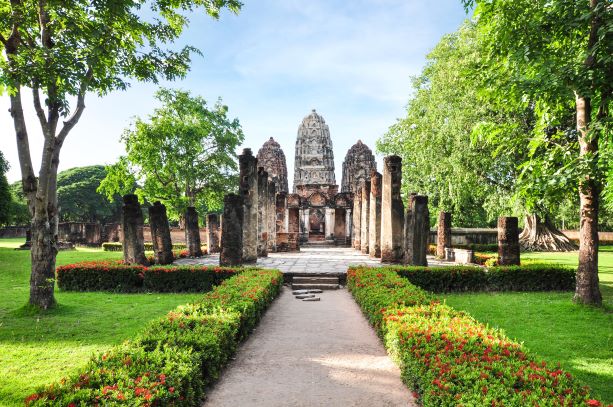
The temple sited in the south of Wat Mahathat which is about 350 meters in its distance. The ancient remains that located inside the monastery complex are included 3 prang style pagodas that influenced by Lopburi art. The prangs are a quite narrow set over the low platform, and some pattern details of the stupa are similar to the pattern on China wares in the period of the Yuan Dynasty. The Naraibunthomsin lintel (the lintel engraved the image of Vishnu asleep on the cosmic ocean at the back of a great Naga) was discovered here, as well as parts of the icon and Shiva lingam. It shows that the site used to be the abode of gods in Hindu religion and then was transformed to be the Buddhist place by annex the sanctuary in front of the complex and appointed it as the Buddhist temple at last.
Apart from the aforementioned, there are more interesting historical ruins and archeological finds outside the area of the city wall which are by following;
9. Wat Sri Chum
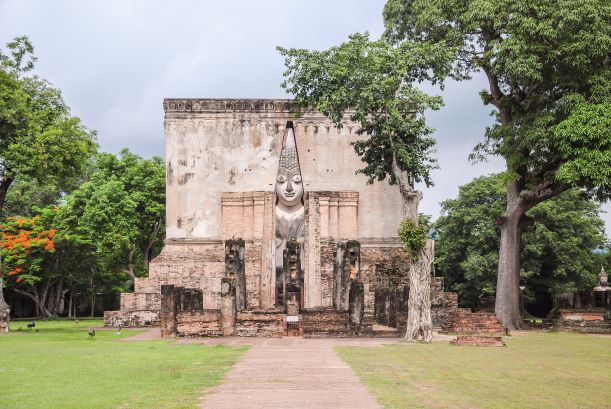
The notable old temple of the ancient city is 800 meters away from Wat Phra Phai Luang to the west. The temple is a house to enshrine the remarkable Buddha statue in the attitude of subduing Mara called “Phra Ajana” with 11.30 meters wide between the knees. The vihara at this monastery is in the squared design similar to the monthop (a blocked shape building with the stepped pyramid roof); unfortunately, the top part already destroyed and just four sides of the wall remaining. Each side of the fence is strong masonry structure; specifically, the south wall provided the hole to allow the people to get inside. Walking through that wall is the ascending path along the narrow steps to reach the side wall next to the Phra Ajana statue or even leads to the upper wall.
Inside the embrasure is the old mural painting that can date back nearly seven centuries, however it almost dissolved. Furthermore, the ceiling above the staircase is a huge slate craved the pattern about the Jataka or the tales of the Lord Buddha’s former births in totally 50 pictures. The path along the staircase leading to the upper part of the vihara providing the beautiful and panoramic view of Sukhothai district.
There are many presumptions regarding the mysterious design of the sanctuary of Wat Sri Chum. Nonetheless, to consider comprehensively founded that the kings of the house of Phra Ruang are skillful at encouraging the armed force as well as other talents to rule the country. The wall next to Phra Ajana statue is a small hole which is anyone entering the tunnel to this gap and speaks out loud, the people inside the hall might think that the word of the important Buddha image. Moreover, the sound is resonated and dignified resulted from there was no window inside the vihara and presumed that it might have the dome shape upper part, originally.
10. Wat Chedi Si Hong

The holy site is 100 meters in the east of Wat Chetuphon. The complex consists of the ancient remains that would be exciting to visit are the base of the pagoda with the stucco images furnished all around. Those images are the pictures of men and ladies with fully dress with the containers in the hands, and the plants grew out represented the flourishment. Besides, the stucco figure of elephant and Singha decorated with the man’s image, too. The main pagoda is the round belled shape that was repaired, yet the top of the chedi fell apart.
11. Wat Saphan Hin
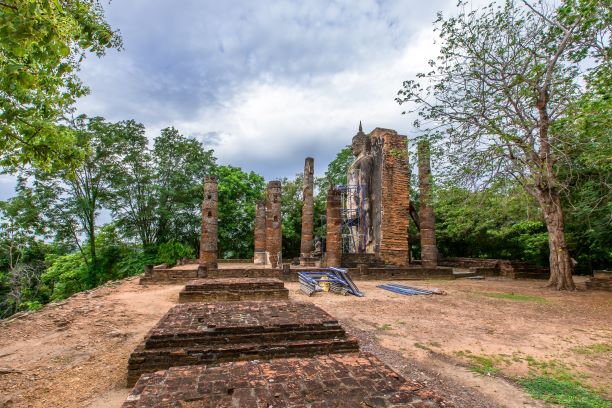
Also called Wat Taphan Hin. The name of the temple derived from the ancient stone bridge which is the path to ascend to the temple located on a small hill. The stone bridge is approximately 1.5 meters in its width made from the slate. Seemingly the stone wall, the bridge is 300 meters long lines from the foot of the hill to the peak that is the location of Wat Saphan Hin. The spot is about 200 meters from the ground and provides the top-eyes-view scenery.
Visiting the temple in the morning is brilliant since Wat Saphan Hin is a good definition of the term “Sukhothai” which means “the dawn of the happiness” very well. Also, the highlight of this temple that anyone should not miss is the main Buddha image named “Phra Attharot” that faced to the east to bless the people of Sukhothai in every morning.
12. The Historic Site of the ceramic in the ancient Sukhothai (Turieng Kiln)
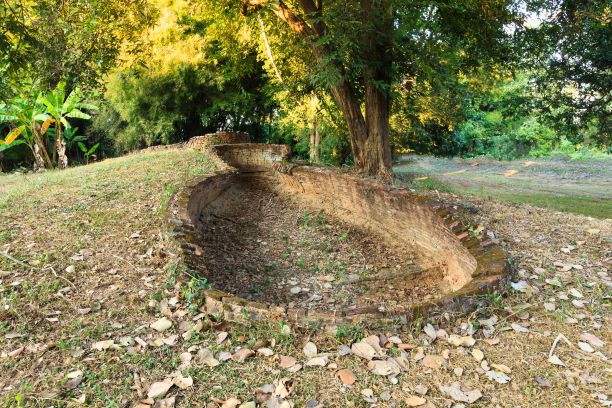
The site is not far from Wat Phra Phai Luang around the area of the old city moat called “Mae Jon”. It is an ancient kiln since the Sukhothai era which dated back to the 18th Buddhist Centuries. There are 49 kilns founded at the location which mostly are at the ridge of Mae Jon river in the north are 37 kilns, in the south next to the city wall are 9 kilns, and 3 units in the east. The celadon kiln is similar to the wagon hood with about 1.50 – 2 meters wide and 4.5 meters in its length. Most of the ceramics founded in this area are large, and the lacquer is dull grey and yellow with black lines. The patterns are flowers, fish, and chakra (wheel).
Tourist Information
Sukhothai Historical Park charges the visitors only THB10 for Thai and THB40 for the foreigners. The tourist can purchase the pool ticket which is THB30 for Thai and THB150 for the foreign visitors. This type of badge can access any historical sites in Sukhothai within 30 days.
And taking the tour inside the historical park is ok whether by walk or bicycle. The park provides the bicycle rental service for the tourist or if anyone would like to spend the day to lingeringly walk and indulge the ancient environment is also exceptional because of the pleasant and shady atmosphere of the park.
Sukhothai Historical Park opens daily from 6.00am through 9.00pm (the ticket closed at 6.00pm).
Note: between 7.00pm – 9.00pm the place is light up to present the dazzling appearance of the historical park in the nightfall.
How to Get there
The visitors can travel to Sukhothai Historical Park in various options including;
By Car:
There are 2 directions which are
- From highway number 1, drives pass Nakhonsawan and Kamphaengphet to enter highway number 101. Then, travels to Pran Kratai district and Kirimas district to reach Sukhothai. The distance in total is 440 km.
- Drives along the highway number 1 until you arrive at the 50th km at Bang Pa-In Junction in Ayutthaya province. So, enters the highway number 117 and heads to Phitsanulok and turns to the road number 12 to enter Sukhothai province. The total distance is 427 km.
By Public Transport:
(taking about 7 hours.) Transport Company Limited provides the services in both regular and air-conditioned bus. The bus departs from Mo Chit Terminal on Kamphaengphet 2 road in Bangkok every day. For more information, please visit the website www.transport.co.th
More than that, there are many private bus operators provide the service route Bangkok – Sukhothai, too.
By Train:
There is the fast and express train from Hua Lamphong Station in Bangkok to Phitsanulok station daily. And then you take the public bus to Sukhothai which is approximately 59 km more of the distance.



